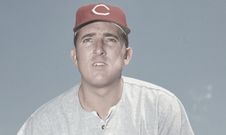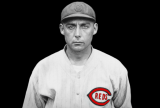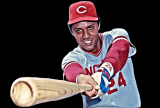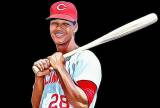This is the sixth installment in a series that looks at the greatest players in franchise histories, based on Wins Above Replacement.
This list was originally published in March of 2020.

Maybe only three or four pitchers could throw a baseball as hard as Maloney in the 1960s. The Fresno native signed with Cincinnati for a reported $100,000 in 1959 when he was 19 years old. A year later he was in the Cincy rotation, three years after that he won 23 games. His fastball was clocked at 99 miles per hour (probably 101-102 using more accurate methods today), and in 1965 he threw a pair of no-hitters (though one of them is not considered a no-no under modern rules). He added an official second no-hitter in 1969, when he was still just 29 years old and in his tenth big league season.
His shoulder blew up basically, and Maloney’s career was over at the age of 31. He probably had the best raw stuff of anyone to ever put on a Cincinnati uniform, with the possible exception of Jose Rijo.

Given his role on the 1990 World Series champions, Rijo might be the most popular pitcher in franchise history. He dominated his two starts in the World Series against the A’s, allowing just nine hits combined as the Reds stunned Oakland in a four-game sweep.
After several arm and shoulder injuries, Rijo was out of the majors for five years in his early thirties, but made a remarkable comeback. In 2001, he returned to the major leagues as a relief pitcher with the Reds. By doing so, he became the first player to appear in a game after receiving a Baseball Hall of Fame vote since Minnie Miñoso in 1976.

For my money, the best nickname in the history of baseball belongs to Mullane, who was known as “The Apollo of the Box.” Of course, it was the newspapers who called Mullane that, it really isn’t practical for teammates to call someone “Apollo” without laughing out loud.
One of the great secrets of early baseball that’s lost on modern fans is the fact that the rules changed significantly almost every year before 1901. When Mullane first picked up a baseball to pitch professionally, the mound was low but also five feet closer to the plate than it is now. The foul ball rule changed (several times), and the baseball itself was different practically from game to game. All of that is to say: we must take 19th century statistics with a grain of salt when comparing those players to those who came later.
Mullane averaged 34 wins in his first three full seasons, but of course he was making about 55 starts per season. He was suspended one season for violating his contract, but came back with Cincinnati (then in the American Association) and averaged 30 wins his first three years as a Redleg. As a result, he has 284 wins for his career, one of the highest totals by a pitcher not in the Hall of Fame. But Mullane was probably not much better a pitcher than Don Gullett, just luckier.

What sort of player was George Foster? He was the type of player that could steal home standing up (which he once did against the Braves) and also hit a home run into the upper deck at Three Rivers Stadium in Pittsburgh, where witnesses said they’d never seen a ball travel, not even in batting practice.
Pete Rose questioned Foster’s intensity. Charlie Hustle once said of his teammate: “George is in a class of his own—he and Mike Schmidt—as far as hitting home runs. But you have to do other things. You have to knock a wall down occasionally. You have to get your uniform dirty. I used to go through three uniforms a day. George uses three a month.”

An unusually tall man for his era, Rixey was a star basketball player for the University of Virginia before moving on to professional baseball. He left college due to the promise of $2,000 and went directly to the Phillies. In his second big league start the 21-year old southpaw fired a shutout against the Braves. He won 265 more over the next two decades, 179 of them for the Reds.
Rixey was one of those guys who was always one of the better pitchers in the league, but clearly never the greatest. There was Pete Alexander (his teammate for several years in Philly), and Wilbur Cooper, and also Burleigh Grimes, all superior pitchers. But Rixey maintained his position in the room, a sturdy presence for nearly twenty years. He won 19 games in 1921 when he allowed just one home run in more than 300 innings. The next season the tall lefty won 25, with 26 complete games. He tossed his last pitch for the Reds when he was 42, but usually toiled for mediocre teams.

Sort of the National League’s Ty Cobb. The proud, dour Edd Roush often battled the penny-pinchers in the front office for a pay raise. Like Cobb, Roush was a lefthanded hitter who preferred to hit the ball into the holes offered by the defense rather than swing from the heels.
“Some batters, and good ones too,” Roush said, “scoff at the whole theory of place hitting, calling it a myth. They are wrong, however.” Like The Georgia Peach, Roush was an aggressive base runner with a nasty disposition known for spiking infielders and making a fist when he needed to. He was a better defender than Cobb, and obviously nowhere near Ty’s class as a hitter, but Roush did manage to hit .323 in his 18-year Hall of Fame career.

When Concepcion first arrived in the big leagues he was raw. He had excellent range with his long legs and arms, and he was cat-like quick, but he struggled to tame his throws. He only carried 158 pounds on his Gumby-like 6’2 frame. After hearing coach Alex Grammas holler “Fire the ball, don’t aim it!”, the young shortstop gradually improved into the most dynamic shortstop before the emergence of Ozzie Smith. But few thought he would hit enough to stay in the lineup. His manager, Sparky Anderson, was convinced that Concepcion would never hit big league pitching. That’s where Ted Kluszewski came in, the Reds’ hitting coach. With Big Klu guiding him, Davey slowly improved at the plate. Kluszewski instructed the youngster to switch to a lighter bat and move closer to the plate. “It’s the speed of the bat, not how hard you swing,” Klu said. Davey was never a real threat, but he was a better hitter than most shortstops of his era, better than Ozzie and Larry Bowa, and his other competition. He also stole 20 bases six times and revolutionized the way shortstops played on artificial turf.
I’ve always thought that if Concepcion had played for the Dodgers or Orioles his entire career, instead of in Cincinnati, he would have been a much bigger star. Not simply because he would have been out of the shadow of his famous teammates, but he would have played behind better pitching staffs. Give Davey 80 more groundballs every season and he could have broke some defensive records before anyone knew who Ozzie was.

One of the most unusual players in the history of the game. Groh took his stance at the very front of the batters’ box and he liked to stand with an open posture. He used a famous “bottle bat” that looked like a table leg. The barrel was three times the size of the handle and dramatically flared. It was one of the heaviest bats in use. Groh’s offensive strategy was to pound the ball into the ground in an effort to get a high hop or push the ball past an infielder. He was also a great bunter who liked to drag the ball toward first base from his right-handed spot in the box. He usually choked up on the big bat but he could also swing away, and he led the league in doubles twice.
His strange approach to hitting might have unnerved pitchers: he led the league in walks once and ranked in the top five on five occasions. He also usually finished near the top of the league in being hit by pitches. From 1915 to 1918, no other batter in the National League got on base as often as Groh.
He frequently batted behind Edd Roush in the batting order and the two of them worked out a number of hit-and-run and steal plays. In 1924 Groh suffered a serious knee injury and he served the following three years as a player/coach appearing in a handful of games each year for the Giants and Pirates.

A light-skinned Cuban, so light-skinned that he could play in the major leagues decades before integration. But Luque couldn’t escape the stereotypes of Latin players during his long and successful career in the States.
Once, during a game in the 1920s between the Reds and Giants, Luque was on the hill and taking an earful from the New York bench, who questioned his heritage in ugly commentary. Luque finally had enough and stalked into the Giants’ dugout to take on the hecklers. According to some sources, the main culprit was Casey Stengel, and according to one story, Luque pounded the little outfielder. But other accounts are less hyperbolic. At any rate, the Luque vs. Giants incident became legend and was used by the press to support the stereotype of Latin players as “hot heads.”
Luque pitched 20 seasons in the U.S., but he also tossed 34 seasons in Cuban leagues, throwing his last professional pitch when he was 55 years old. He was known for a sharp breaking ball (curve), and a sneaky-quick fastball. But the 5’7 Luque was not a power pitcher, he preferred to keep hitters off balance, unafraid to pitch up and in when needed.


Appears on this list because of the way pitchers were used in the early twentieth century: Hahn averaged 34 complete games in his six full seasons with the Redlegs.
He won his 100th game before his 24th birthday, but an arm injury (not surprising considering he averaged 300 innings per season for half a decade starting at the age of 20), halted his career. Hahn won eight games after the age of 25.
After the arm injury ended his career, Noodles maintained a close relationship with the Cincinnati ball club. He returned to the team almost every spring to pitch batting practice in training camp and even kept a locker in the clubhouse into the 1940s.

The Reds’ dominance ended abruptly when they traded Perez to the Expos at the winter meetings in 1976 for two relief pitchers. Looking at it logically, the deal made sense: Perez was turning 35 in 1977 and coming off his most disappointing season in years. At that time, a 35-year old ballplayer was ancient, and the Reds had a young, hard-hitting replacement in Dan Driessen, who was champing at the bit. Cincinnati GM Bob Howsam courted criticism in trading Perez, one of the team’s famed “Big Four,” but it wasn’t a bad decision on paper.
Unfortunately for Howsam, Perez was more than a set of statistics. He was the glue that kept the Reds clubhouse together, the man who bridged the divide between Pete Rose and Joe Morgan and Johnny Bench. He was skilled at mollifying Dave Concepcion, who desperately wanted to join his more famous teammates in the inner circle. Perez was the man who went to manager Sparky Anderson and gave him a heads up when Bench or Rose had their nose out of joint. And Perez (or “Doggie” as his teammates affectionately called him), was a great hitter who had a knack for rising to the occasion.


In an age when defenders played without a glove, Bid McPhee had the surest hands of any middle infielder. He was an early adopter of the hop and flip style of double play, and he had a strong arm. Reportedly, he soaked his hands in salt water to toughen them.
He was typically a leadoff batter who swung from the heels, and he was quick without being really fast. He was really just above average as an offensive player, but he stood out as a defender in the 19th century as much Ozzie Smith did in his era. There was no other second baseman in his class in the field.

Morgan was small, only about 5’7 and 160 pounds. Remember that runt, David Eckstein, how he looked so out of place at shortstop for the Angels in the early 2000s? Eckstein was ten pounds heavier than Little Joe. But Morgan could do it all: hit, hit for power, play infield, run like a deer, all the things you want.


In his rookie season, Robinson hit 38 home runs and led the league with 122 runs. He was named Rookie of the Year and more importantly, his arrival helped the Reds improve by 16 wins. If there was one adjective that described Robinson it was “winner.” In 1961 he led the Reds to their first pennant in 21 years. Five years later after Cincinnati traded him because they thought he was too old, Robby won the Triple Crown, his second MVP and led the Orioles to their first championship. In six seasons in Baltimore, Robinson sparked them to four pennants and two World Series titles. From changing team fortunes, Robinson went on to change baseball.
In 1975, Robinson became the first black manager in Major League Baseball when he was hired as player/manager in Cleveland. He later became the first black manager in National League history and won the Manager of the Year Award with Baltimore. Years later, MLB hired him to serve as special assistant to the commissioner.

Larkin wanted to be a shortstop since he was a kid watching his idol Ozzie Smith on television. Growing up in Cincinnati he wanted to play for the Reds and replace Dave Concepcion at short. “That was what I always told myself,” Larkin said early in his career. “Concepcion was near the end of a great career, and I wanted to replace him. I wanted to play as long as he did with the Reds, and I wanted to be known as the Reds best all-time shortstop.”
When he got to the Reds (replacing Concepcion) he wanted uniform #1 to honor Ozzie, but the equipment guy told Barry that the team had retired that number for Fred Hutchinson. Larkin had no idea who Hutchinson was, but he asked for #11 to reinforce how much he admired Smith. Barry eventually wrestled the Gold Glove Award away from Ozzie, won an MVP award, and his number is now retired by the Reds too.


Could Rose have been a great player without the hubris? Probably not. He needed it to fuel his unyielding desire to play every day, to focus in every situation, even in the eighth inning of a meaningless six-run game against the Cubs in September. Like Pacman, Pete was hungry for everything in his path: every hit, every base, every run. He gobbled up more than anyone ever has.
Rose played in more winning games than anyone in history. If the Big Red Machine was the greatest team of all-time (and in my opinion, it was), Charlie Hustle was the oil that lubricated the engine.
This feature list was written by Dan Holmes, founder of Baseball Egg. Dan is author of three books on baseball, including Ty Cobb: A Biography, The Great Baseball Argument Settling Book, and more. He previously worked as a writer and digital producer for the National Baseball Hall of Fame, as well as Major League Baseball Advanced Media.
No reproduction of this content is permitted without permission of the copyright holder. Links and shares are welcome.